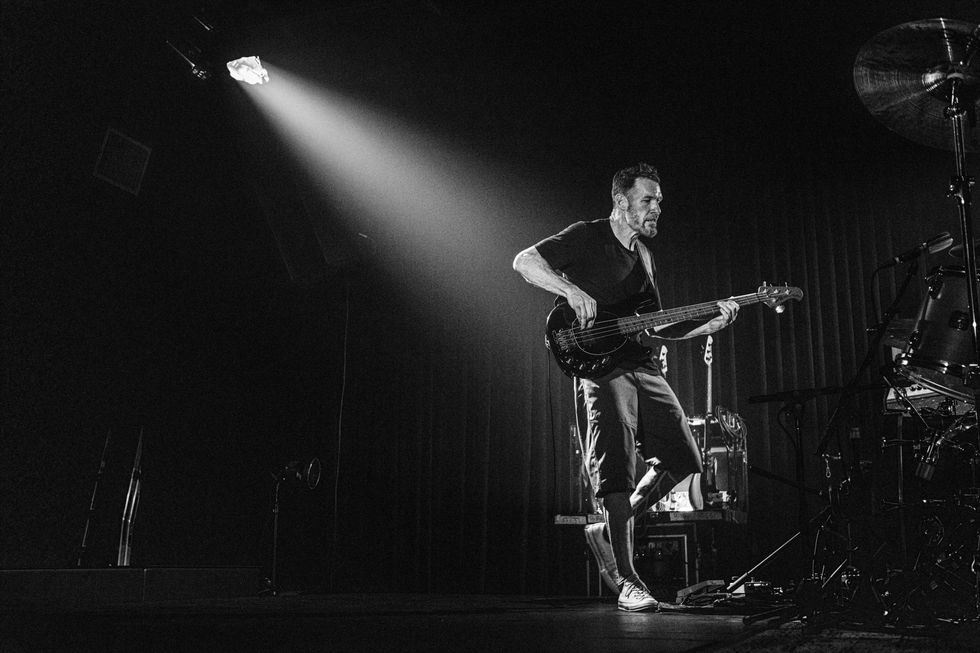
The story of the Ernie Ball Music Man StingRay is a deep journey through the history of the electric guitar business, going way back to connections made in Leo Fender’s early days. When the StingRay was introduced in 1976, it changed the electric-bass game, and it’s still the instrument of choice for some of the most cutting-edge bass players around. Here’s what a few of them have to say about their StingRays:
Joe Dart (Vulfpeck)
“My first glimpse of a StingRay was watching early videos of Flea, who had a black StingRay that he played in an early instructional video, as well as on the Funky Monks tape, showing the making of Blood Sugar Sex Magik. After that, I discovered Bernard Edwards and his playing with Chic, where he developed such an iconic funk and disco sound. From there, I discovered Pino Palladino’s brilliant fretless StingRay playing. Luckily, one day in the studio, someone handed me an old StingRay, and I used it on a couple of Vulfpeck recordings. I love the punchy, growly, bright tone. The StingRay cuts through the mix. It’s the perfect funk and disco bass.
Pino Palladino
“I played guitar in bands until 1976, when I decided to start playing bass, and that coincided with the StingRay coming out. I actually tried one in a store in Cardiff in Wales, where I come from. I remember plugging it in, and I didn’t really know much about preamps. I don’t think anybody knew much about preamps back then, because it wasn’t even a thing in a bass guitar. So, I turned everything up and it was too trebly for me. I didn’t know you could tweak the controls. I didn’t gravitate towards the instrument at first, to be honest.
Fast forward a few years and I was in my early twenties on my first trip to America with Jools Holland in 1981. I stumbled into Sam Ash Music on 48th Street in New York one day, and I saw a fretless Music Man StingRay on the wall. It sounded amazing straight away. I hadn’t played much fretless bass up until that point, but for some reason I could just play that instrument in tune. I was playing it and thinking, ‘Wow, this is not so hard.’ I backed off the treble a little bit and found a nice, little happy position where it felt really good. And it just had such a great punchy sound. I played it with Jools Holland on the first night I bought it, and I pretty much never put it down for 10 or 15 years after that.”
Tim Commerford (Rage Against the Machine)
“I got a blonde StingRay when I was about 19 years old, and that was the bass that I played for the first Rage record. At that time in my life, as a musician, I was kind of clueless to the nuances of the sound of an instrument. If it worked, it worked; if it didn’t work for me, it didn’t. I was just a knucklehead. I can’t even remember the reason why I went away from it. I think it’s because I wanted to get a real edgy sound, and I didn’t really know how to shape things in the way that I do now through experimenting. I’ve been very lucky, and I’ve had a lot of opportunities to experiment, so I’ve learned a lot over the years. And the StingRay could have done it all. I really could have done it all with the StingRay. Long story short, the preamp is arguably the best one, still. It took me a minute to realize just how powerful that preamp is—it’s a banger. Listening back, sometimes I hear [Rage Against the Machine] songs on the radio, and I’m just like, ‘Wow.’ It’s such a clean, pristine sound that comes from a StingRay.”
From Your Site Articles
Related Articles Around the Web









